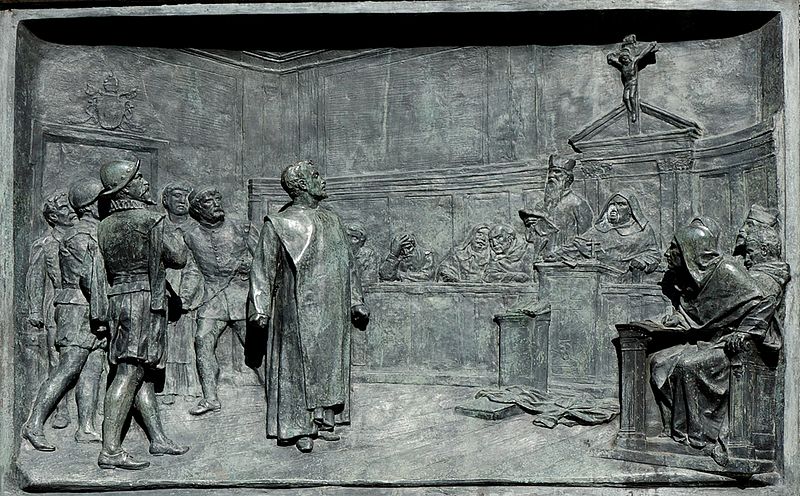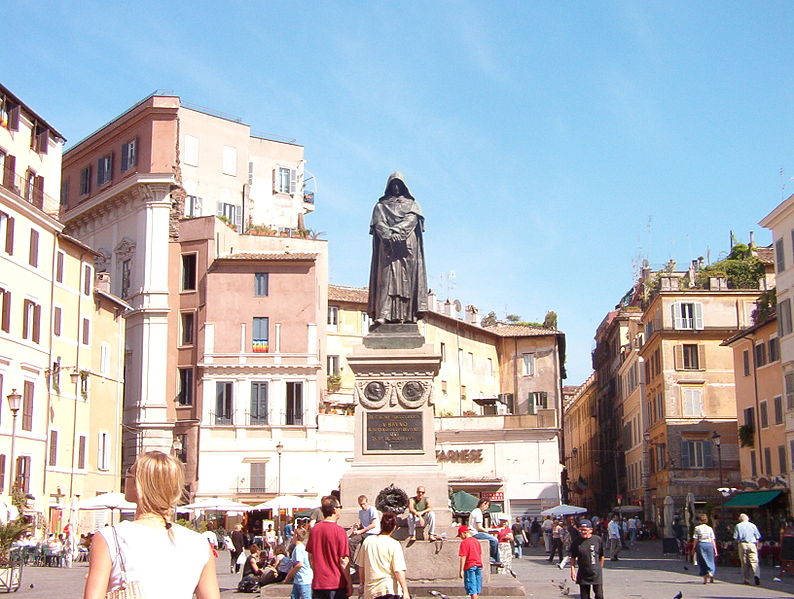<Back to Index>
- Philosopher and Astronomer Giordano (Filippo) Bruno, 1548
- Writer and Physician Mori Ōgai, 1862
- Cofounder of Vlaamsche Volkspartij Lodewijk De Raet, 1870
PAGE SPONSOR
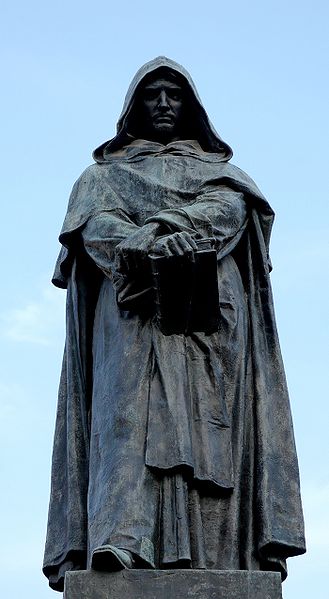
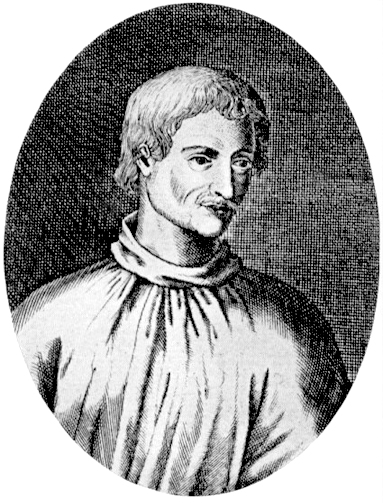
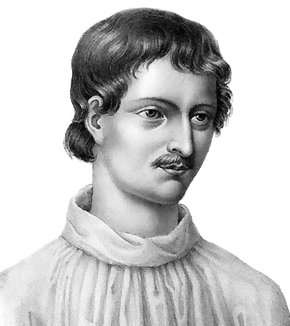
Giordano Bruno (1548 – February 17, 1600), born Filippo Bruno, was an Italian Dominican friar, philosopher, mathematician and astronomer. His cosmological theories went beyond the Copernican model in proposing that the Sun was essentially a star, and moreover, that the universe contained an infinite number of inhabited worlds populated by other intelligent beings. He was burned at the stake by civil authorities in 1600 after the Roman Inquisition found him guilty of heresy for his pantheism and turned him over to the state, which at that time considered heresy illegal. After his death he gained considerable fame; in the 19th and early 20th centuries, commentators focusing on his astronomical beliefs regarded him as a martyr for free thought and modern scientific ideas.
Recent assessments suggest that
Bruno's ideas about the universe played a smaller role
in his trial than his pantheist beliefs, which
differed from the interpretations and scope of God held by
the Catholic Church. In addition
to his cosmological writings, Bruno also wrote
extensive works on the art of memory, a
loosely organized group of mnemonic techniques
and principles. More recent assessments, beginning
with the pioneering work of Frances Yates, suggest
that Bruno was deeply influenced by the astronomical
facts of the universe inherited from Arab astrology, Neoplatonism and
Renaissance Hermeticism. Other recent
studies of Bruno have focused on his qualitative
approach to mathematics and his application of the
spatial paradigms of geometry to language.
Filippo Bruno was born in Nola (in Campania, then part of the Kingdom of Naples) in 1548, the son of Giovanni Bruno, a soldier, and Fraulissa Savolino. In his youth he was sent to Naples for education. He was tutored privately at the Augustinian monastery there, and attended public lectures at the Studium Generale. At the age of 17, he entered the Dominican Order at the monastery of San Domenico Maggiore in Naples, taking the name Giordano, after Giordano Crispo, his metaphysics tutor. He continued his studies there, completing his novitiate, and became an ordained priest in 1572 at age 24. During his time in Naples he became known for his skill with the art of memory and on one occasion traveled to Rome to demonstrate his mnemonic system before Pope Pius V and Cardinal Rebiba. In his later years Bruno claimed that the Pope accepted his dedication to him of the lost work On The Ark of Noah at this time.
Such an honor suggests that
Bruno was distinguished for outstanding ability. But
Bruno's taste for free thinking and forbidden books
soon caused him difficulties, and given the
controversy he caused in later life it is surprising
that he was able to remain within the monastic system
for eleven years. In his testimony to Venetian
inquisitors during his trial, many years later, he
indicates that proceedings were twice taken against
him for having cast away images of the saints,
retaining only a crucifix, and for having made
controversial reading recommendations to a novice.
Such behavior could perhaps be overlooked, but Bruno's
situation became much more serious when he was
reported to have defended the Arian heresy, and when
a copy of the banned writings of Erasmus, annotated by him, was discovered
hidden in the convent privy. When he learned that an
indictment was being prepared against him in Naples he
fled, shedding his religious habit, at least for a
time.
Bruno first went to the Genoese port of Noli, then to Savona, Turin and finally to Venice, where he published his lost work On The Signs of the Times with the permission (so he claimed at his trial) of the Dominican Remigio Nannini Fiorentino. From Venice he went to Padua where he met fellow Dominicans who convinced him to wear his religious habit again. From Padua he went to Bergamo and then across the Alps to Chambéry and Lyon. His movements after this time are obscure.
In 1579 he arrived in Geneva. As D.W. Singer, a Bruno biographer, notes, "The question has sometimes been raised as to whether Bruno became a Protestant, but it is intrinsically most unlikely that he accepted membership in Calvin's communion". During his Venetian trial he told inquisitors that while in Geneva he told the Marchese de Vico of Naples, who was notable for helping Italian refugees in Geneva, "I did not intend to adopt the religion of the city. I desired to stay there only that I might live at liberty and in security." Bruno had a pair of breeches made for himself, and the Marchese and others apparently made Bruno a gift of a sword, hat, cape and other necessities for dressing himself; in such clothing Bruno could no longer be recognized as a priest. Things apparently went well for Bruno for a time, as he entered his name in the Rector's Book of the University of Geneva in May of 1579. But in keeping with his personality he could not long remain silent. In August he published an attack on the work of Antoine de la Faye, a distinguished professor. He and the printer were promptly arrested. Rather than apologizing, Bruno insisted on continuing to defend his publication. He was refused the right to take sacrament. Though this was eventually reversed, he left Geneva.
He left for France, arriving first in Lyon, and thereafter settling for a time (1580 – 1581) in Toulouse, where he took his doctorate in theology and was elected by students to lecture in philosophy. It seems he also attempted at this time to return to the Catholic fold, but was denied absolution by the Jesuit priest he approached. When religious strife broke out in the summer of 1581, he relocated to Paris. There he held a cycle of thirty lectures on theological topics, and he also began to gain fame for his prodigious memory. Bruno's feats of memory were based, at least in part, on his elaborate system of mnemonics, but some of his contemporaries found it easier to attribute them to magical powers. His talents attracted the benevolent attention of the king Henry III. The king summoned him to the court. Bruno subsequently reported "I got me such a name that King Henry III summoned me one day to discover from me if the memory which I possessed was natural or acquired by magic art. I satisfied him that it did not come from sorcery but from organised knowledge; and, following this, I got a book on memory printed, entitled 'The Shadows of Ideas', which I dedicated to His Majesty. Forthwith he gave me an Extraordinary Lectureship with a salary."
In Paris Bruno enjoyed the protection of his powerful French patrons. During this period, he published several works on mnemonics, including De umbris idearum (On The Shadows of Ideas, 1582), Ars Memoriae (The Art of Memory, 1582), and Cantus Circaeus (Circe's Song, 1582). All of these were based on his mnemonic models of organised knowledge and experience, as opposed to the simplistic logic based mnemonic techniques of Petrus Ramus then becoming popular. Bruno also published a comedy summarizing some of his philosophical positions, titled Il Candelaio (The Torchbearer, 1582). On The Shadows of Ideas was dedicated to King Henry III. In the 16th century dedications were, as a rule, approved beforehand, and hence were a way of placing a work under the protection of an individual. Given that Bruno dedicated various works to the likes of King Henry III, Sir Philip Sidney, Michel de Castelnau (French Ambassador to England), and possibly Pope Pius V, it is apparent that this wanderer had experienced a meteoric rise and moved in powerful circles.
In April 1583, Bruno went to England with letters of recommendation from Henry III as a guest of the French ambassador, Michel de Castelnau. There he became acquainted with the poet Philip Sidney (to whom he dedicated two books) and other members of the Hermetic circle around John Dee, though there is no evidence that Bruno ever met Dee himself. He also lectured at Oxford, and unsuccessfully sought a teaching position there. His views spurred controversy, notably with John Underhill, Rector of Lincoln College and from 1589 bishop of Oxford, and George Abbot, who later became Archbishop of Canterbury, who poked fun at Bruno for supporting “the opinion of Copernicus that the earth did go round, and the heavens did stand still; whereas in truth it was his own head which rather did run round, and his brains did not stand still.” and who reports accusations that Bruno plagiarized Ficino's work. Still, the English period was a fruitful one. During that time Bruno completed and published some of his most important works, the "Italian Dialogues," including the cosmological tracts La Cena de le Ceneri (The Ash Wednesday Supper, 1584), De la Causa, Principio et Uno (On Cause, Principle and Unity, 1584), De l'Infinito Universo et Mondi (On the Infinite Universe and Worlds, 1584) as well as Lo Spaccio de la Bestia Trionfante (The Expulsion of the Triumphant Beast, 1584) and De gl' Heroici Furori (On Heroic Frenzies, 1585). Some of these were printed by John Charlewood. Some of the works that Bruno published in London, notably The Ash Wednesday Supper, appear to have given offense. It was not the first time, nor was it to be the last, that Bruno's controversial views coupled with his abrasive sarcasm lost him the support of his friends. While conclusive proof is wanting, the theory has been advanced that, while he was staying in the French Embassy in London, Bruno was also spying on Catholic conspirators under the pseudonym 'Fagot' for Sir Francis Walsingham, Queen Elizabeth's Secretary of State.
In October 1585, after the
French embassy in London was attacked by a mob,
Bruno returned to Paris with
Castelnau, finding a tense political situation.
Moreover, his 120 theses against Aristotelian natural
science and his pamphlets against the
mathematician
Fabrizio Mordente soon
put him in ill favor. In 1586, following a violent
quarrel about Mordente's invention, "the
differential compass," he left France for Germany.
In Germany he failed to obtain a teaching position at Marburg, but was granted permission to teach at Wittenberg, where he lectured on Aristotle for two years. However, with a change of intellectual climate there, he was no longer welcome, and went in 1588 to Prague, where he obtained 300 taler from Rudolf II, but no teaching position. He went on to serve briefly as a professor in Helmstedt, but had to flee again when he was excommunicated by the Lutherans, continuing the pattern of Bruno's gaining favor from lay authorities before falling foul of the ecclesiastics of whatever hue.
During this period he produced several Latin works, dictated to his friend and secretary Girolamo Besler, including De Magia (On Magic), Theses De Magia (Theses On Magic) and De Vinculis In Genere (A General Account of Bonding). All these were apparently transcribed or recorded by Besler (or Bisler) between 1589 and 1590. He also published De Imaginum, Signorum, Et Idearum Compositione (On The Composition of Images, Signs and Ideas, 1591).
The year 1591 found him in Frankfurt. Apparently, during the Frankfurt Book Fair, he received an invitation to Venice from the patrician Giovanni Mocenigo, who wished to be instructed in the art of memory, and also heard of a vacant chair in mathematics at the University of Padua. Apparently believing that the Inquisition might have lost some of its impetus, he returned to Italy.
He went first to Padua, where he taught briefly, and applied unsuccessfully for the chair of mathematics, which was assigned instead to Galileo Galilei one year later. Bruno accepted Mocenigo's invitation and moved to Venice in March 1592. For about two months he functioned as an in-house tutor to Mocenigo. When Bruno announced his plan to leave Venice to his host, the latter, who was unhappy with the teachings he had received and had apparently developed a personal rancour towards Bruno, denounced him to the Venetian Inquisition, which had Bruno arrested on May 22, 1592. Among the numerous charges of blasphemy and heresy brought against him in Venice, based on Mocenigo's denunciation, was his belief in the plurality of worlds, as well as accusations of personal misconduct. Bruno defended himself skillfully, stressing the philosophical character of some of his positions, denying others and admitting that he had had doubts on some matters of dogma. The Roman Inquisition, however, asked for his transferral to Rome. After several months and some quibbling the Venetian authorities reluctantly consented and Bruno was sent to Rome in February 1593.
In Rome he was imprisoned for
seven years during his lengthy trial, lastly in
the Tower of Nona. Some important
documents about the trial are lost, but others
have been preserved, among them a summary of the
proceedings that was rediscovered in 1940. The
numerous charges against Bruno, based on some of
his books as well as on witness accounts, included
blasphemy, immoral conduct, and heresy in matters
of dogmatic theology, and involved some of the
basic doctrines of his philosophy and cosmology.
Luigi Firpo lists them as follows:
- Holding opinions contrary to the Catholic Faith and speaking against it and its ministers.
- Holding erroneous opinions about the Trinity, about Christ's divinity and Incarnation.
- Holding erroneous opinions about Christ.
- Holding erroneous opinions about Transubstantiation and Mass.
- Claiming the existence of a plurality of worlds and their eternity.
- Believing in metempsychosis and in the transmigration of the human soul into brutes.
- Dealing in magics and divination.
- Denying the Virginity of Mary.
In these grim circumstances Bruno continued his Venetian defensive strategy, which consisted in bowing to the Church's dogmatic teachings, while trying to preserve the basis of his philosophy. In particular Bruno held firm to his belief in the plurality of worlds, although he was admonished to abandon it. His trial was overseen by the Inquisitor Cardinal Bellarmine, who demanded a full recantation, which Bruno eventually refused. Instead he appealed in vain to Pope Clement VIII, hoping to save his life through a partial recantation. The Pope expressed himself in favor of a guilty verdict, recommending a sentence of death. Consequently, Bruno was declared a heretic, and told he would be handed over to secular authorities. According to the correspondence of one Gaspar Schopp of Breslau, he is said to have made a threatening gesture towards his judges and to have replied:
"Maiori forsan cum timore sententiam in me fertis quam ego accipiam (Perhaps you pronounce this sentence against me with greater fear than I receive it)." He was quickly turned over to the secular authorities and, on February 17, 1600 in the Campo de' Fiori, a central Roman market square, "his tongue imprisoned because of his wicked words" he was burned at the stake. His ashes were dumped into the Tiber river. All of Bruno's works were placed on the Index Librorum Prohibitorum in 1603. Inquisition Cardinals who judged Giordano Bruno were: St. Roberto Francesco Romolo Cardinal Bellarmino (Bellarmine), Carlo Gaudenzio Cardinal Madruzzo (Madruzzi), Cardinal Camillo Borghese (later Pope Paul V), Domenico Cardinal Pinelli, Pompeio Cardinal Arrigoni, Paolo Emilio Cardinal Sfondrati, Pedro Cardinal De Deza Manuel, Giulio Antonio Cardinal Santorio (Archbishop of Santa Severina, Cardinal - Bishop of Palestrina).
In the years since Bruno's
execution, the Vatican has published few official
statements about the matter. In 1942, Cardinal
Mercati, who discovered the lost documents
relating to Bruno's trial, stated that the Church
was perfectly justified in condemning Bruno.
Later, on the 400th anniversary of Bruno's death,
Cardinal Angelo Sodano declared
Bruno's
death to be a "sad episode" but, despite his
regret, he defended Bruno's persecutors,
maintaining that the Inquisitors were "motivated
by the desire to serve the truth and promote the
common good, also doing their utmost to save his
life" by trying to make him recant and
subsequently by appealing the capital punishment
with the secular authorities of Rome.
Some authors have characterized Bruno as a "martyr of science," suggesting parallels with the Galileo affair. They assert that, even though Bruno's theological beliefs were an important factor in his heresy trial, his Copernicanism and cosmological beliefs also played a significant role for the outcome. Others oppose such views, and claim this alleged connection to be exaggerated, or outright false.
According to the Stanford Encyclopedia of Philosophy, "in 1600 there was no official Catholic position on the Copernican system, and it was certainly not a heresy. When [...] Bruno [...] was burned at the stake as a heretic, it had nothing to do with his writings in support of Copernican cosmology."
Similarly, the Catholic Encyclopedia (1908) asserts that "Bruno was not condemned for his defence of the Copernican system of astronomy, nor for his doctrine of the plurality of inhabited worlds, but for his theological errors, among which were the following: that Christ was not God but merely an unusually skillful magician, that the Holy Ghost is the soul of the world, that the Devil will be saved, etc."
A different perspective may be found on the webpage of the Vatican Secret Archives. Discussing the document containing a summary of legal proceedings against Bruno in Rome, it asserts: "In the same rooms where Giordano Bruno was questioned, for the same important reasons of the relationship between science and faith, at the dawning of the new astronomy and at the decline of Aristotle’s philosophy, sixteen years later, Cardinal Bellarmino, who then contested Bruno's heretical theses, summoned Galileo Galilei, who also faced a famous inquisitorial trial, which, luckily for him, ended with a simple abjuration."
Following the 1870 Capture of Rome by the newly created Kingdom of Italy and the end of the Church's temporal power over the city, the erection of a monument to Bruno on the site of his execution became feasible. In 1885 an international committee was formed for that purpose, including Victor Hugo, Herbert Spencer, Ernest Renan, Ernst Haeckel, Henrik Ibsen and Ferdinand Gregorovius. The monument was sharply opposed by the clerical party, but was finally erected by the Rome Municipality and inaugurated in 1889.
A statue of a stretched human
figure standing on its head designed by Alexander
Polzin depicting Bruno's death at the stake was placed
in Potsdamer Platz station in Berlin on March
2, 2008.
Bruno was a believer in polygenism, that each race had been created separately, he believed in CoAdamism; that there were more than one Adam, and that there were also an infinite number of Gardens of Eden:
I can imagine an infinite number of worlds like the Earth, with a Garden of Eden on each one. In all these Gardens of Eden, half the Adams and Eves will not eat the fruit of knowledge, and half will. But half of infinity is infinity, so an infinite number of worlds will fall from grace and there will be an infinite number of crucifixions.
— Giordano Bruno, 'On the Cause, Principle, and Unity', 5th dialogue
In 1591 Bruno argued that because no one could imagine that the Jews and the Ethiopians had the same ancestry that God must have either created separate Adams or that Africans were the descendants of pre-Adamite races.
According
to Aristotle and Plato, the universe was
a finite sphere. Its ultimate
limit was the primum
mobile, whose diurnal rotation was conferred
upon it by a transcendental God, not part of the
universe, a motionless prime mover and first cause. The fixed stars were part of
this celestial sphere, all at the same fixed distance
from the immobile earth at the center of the sphere. Ptolemy had
numbered these at 1,022, grouped into 48 constellations. The planets were each
fixed to a transparent sphere.
In the first half of the 15th century Nicolaus Cusanus (not to be confused with Copernicus a century later) reissued the ideas formulated in Antiquity by Democritus and Lucretius and dropped the Aristotelean cosmos. He envisioned an infinite universe, whose center was everywhere and circumference nowhere, with countless rotating stars, the Earth being one of them, of equal importance. He also considered that neither were the rotational orbits circular, nor was the movement uniform.
In the second half of the 16th century, the theories of Copernicus (1473 – 1543) began diffusing through Europe. Copernicus conserved the idea of planets fixed to solid spheres, but considered the apparent motion of the stars to be an illusion caused by the rotation of the Earth on its axis; he also preserved the notion of an immobile center, but it was the Sun rather than the Earth. Copernicus also argued the Earth was a planet orbiting the Sun once every year. However he maintained the Ptolemaic hypothesis that the orbits of the planets were composed of perfect circles — deferents and epicycles — and that the stars were fixed on a stationary outer sphere.
Few astronomers of
Bruno's time accepted Copernicus's heliocentric model. Among
those who did were the Germans Michael Maestlin (1550
– 1631), Christoph Rothmann, Johannes Kepler (1571 –
1630), the Englishman Thomas Digges, author
of A
Perfit Description of the Caelestial Orbes, and the Italian Galileo Galilei (1564 –
1642). Curiously, Bruno's Nolan compatriot, Nicola Antonio Stigliola, born just two
years before Bruno himself, believed in the Copernican
model. The two, however, probably never met after
their youth.
Bruno believed (and praised Copernicus for establishing a scientific explanation for the fact) that the Earth revolves around the sun, and that the apparent diurnal rotation of the heavens is an illusion caused by the rotation of the Earth around its axis. Bruno also held (following Nicholas of Cusa) that because God is infinite the universe would reflect this fact in boundless immensity.
The universe is then one, infinite, immobile.... It is not capable of comprehension and therefore is endless and limitless, and to that extent infinite and indeterminable, and consequently immobile.
Bruno also asserted that the stars in the sky were really other suns like our own, around which orbited other planets. He indicated that support for such beliefs in no way contradicted scripture or true religion.
In 1584, Bruno published two important philosophical dialogues, in which he argued against the planetary spheres (two years later, Rothmann did the same, as did Tycho Brahe in 1587). Bruno's infinite universe was filled with a substance — a "pure air," aether, or spiritus -- that offered no resistance to the heavenly bodies which, in Bruno's view, rather than being fixed, moved under their own impetus (momentum). Most dramatically, he completely abandoned the idea of a hierarchical universe. The Earth was just one more heavenly body, as was the Sun. God had no particular relation to one part of the infinite universe more than any other. God, according to Bruno, was as present on Earth as in the Heavens, an immanent God, the One subsuming in itself the multiplicity of existence, rather than a remote heavenly deity.
Bruno also affirmed that the universe was homogeneous, made up everywhere of the four elements (water, earth, fire, and air), rather than having the stars be composed of a separate quintessence. Essentially, the same physical laws would operate everywhere, although the use of that term is anachronistic. Space and time were both conceived as infinite. There was no room in his stable and permanent universe for the Christian notions of divine creation and Last Judgement.
Under this model, the Sun was simply one more star, and the stars all suns, each with its own planets. Bruno saw a solar system of a sun / star with planets as the fundamental unit of the universe. According to Bruno, infinite God necessarily created an infinite universe, formed of an infinite number of solar systems, separated by vast regions full of Aether, because empty space could not exist (Bruno did not arrive at the concept of a galaxy). Comets were part of a synodus ex mundis of stars, and not — as other authors maintained at the time — ephemeral creations, divine instruments, or heavenly messengers. Each comet was a world, a permanent celestial body, formed of the four elements.
Bruno's cosmology is marked by infinitude, homogeneity, and isotropy, with planetary systems distributed evenly throughout. Matter follows an active animistic principle: it is intelligent and discontinuous in structure, made up of discrete atoms. This animism (and a corresponding disdain for mathematics as a means to understanding) is the most dramatic respect in which Bruno's cosmology differs from a modern scientific understanding of the universe.
During the later 16th century, and throughout the 17th century, Bruno's ideas were held up for ridicule, debate, or inspiration. Margaret Cavendish, for example, wrote an entire series of poems against "atoms" and "infinite worlds" in Poems and Fancies in 1664. Bruno's true, if partial, rehabilitation would have to wait for the implications of Newtonian cosmology.
Bruno's overall contribution to the birth of modern science is still controversial. Some scholars follow Frances Yates stressing the importance of Bruno's ideas about the universe being infinite and lacking geocentric structure as a crucial crosspoint between the old and the new. Others disagree. Others yet see in Bruno's idea of multiple worlds instantiating the infinite possibilities of a pristine, indivisible One a forerunner of Everett's many - worlds interpretation of quantum mechanics.
Retrospective
'scientific' iconography of Bruno shows him with a
Dominican cowl but not tonsured. Edward Gosselin has
suggested that it is likely Bruno kept his tonsure at least
until 1579, and it is possible that he wore it again
thereafter. When Bruno was imprisoned by the Venetian
inquisition in May of 1592 records describe him as a
man "of average height, with a hazel colored beard and
the appearance of being about forty years of age."
Otherwise, there is a passage in a work by George Abbot suggesting that Bruno was short, "When that Italian Didapper, who intituled himselfe Philotheus Iordanus Brunus Nolanus, magis elaborata Theologia Doctor, &c with a name longer than his body...".
In addition to
mentioning his name is "longer than his body" Abbot
uses the derisive term "didaper" which in period
meant "a small diving waterfowl". Neither of these
descriptions offers enough material upon which to
base a portrait, and no period portrait is known to
exist. The supposed "portraits" of Bruno often seen
derive from two sources, the earlier of which is
clearly the inspiration for the later. The more
recent of the two dates from 1824, and appeared in a
book discussing heroes of modern scientific thought.
The oldest is an engraving published in 1715. According to
Salvestrini the earlier of the two is "the only
known portrait of Bruno". He suggests it might be a
re-engraving made from a lost print. Its
authenticity is doubtful.
